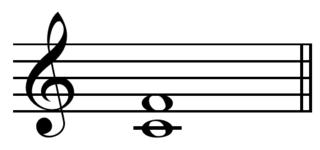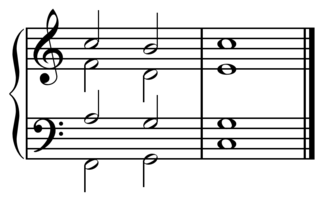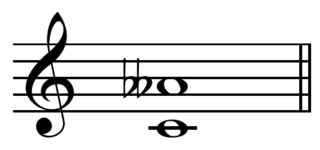In music theory, an interval is a difference in pitch between two sounds. An interval may be described as horizontal, linear, or melodic if it refers to successively sounding tones, such as two adjacent pitches in a melody, and vertical or harmonic if it pertains to simultaneously sounding tones, such as in a chord.

Microtonal music or microtonality is the use in music of microtones—intervals smaller than a semitone, also called "microintervals". It may also be extended to include any music using intervals not found in the customary Western tuning of twelve equal intervals per octave. In other words, a microtone may be thought of as a note that falls between the keys of a piano tuned in equal temperament.
In music theory, the tritone is defined as a musical interval composed of three adjacent whole tones. For instance, the interval from F up to the B above it is a tritone as it can be decomposed into the three adjacent whole tones F–G, G–A, and A–B.

A fourth is a musical interval encompassing four staff positions in the music notation of Western culture, and a perfect fourth is the fourth spanning five semitones. For example, the ascending interval from C to the next F is a perfect fourth, because the note F is the fifth semitone above C, and there are four staff positions between C and F. Diminished and augmented fourths span the same number of staff positions, but consist of a different number of semitones.

In music theory, a perfect fifth is the musical interval corresponding to a pair of pitches with a frequency ratio of 3:2, or very nearly so.

In classical music from Western culture, a diesis is either an accidental, or a very small musical interval, usually defined as the difference between an octave and three justly tuned major thirds, equal to 128:125 or about 41.06 cents. In 12-tone equal temperament three major thirds in a row equal an octave, but three justly-tuned major thirds fall quite a bit narrow of an octave, and the diesis describes the amount by which they are short. For instance, an octave (2:1) spans from C to C', and three justly tuned major thirds (5:4) span from C to B♯. The difference between C-C' (2:1) and C-B♯ (125:64) is the diesis (128:125). Notice that this coincides with the interval between B♯ and C', also called a diminished second.

Tonality is the arrangement of pitches and/or chords of a musical work in a hierarchy of perceived relations, stabilities, attractions and directionality. In this hierarchy, the single pitch or triadic chord with the greatest stability is called the tonic. The root of the tonic chord forms the name given to the key, so in the key of C major, the note C can be both the tonic of the scale and the root of the tonic chord. The tonic can be a different note in the same scale, when the work is said to be in one of the modes of the scale.

A semitone, also called a half step or a half tone, is the smallest musical interval commonly used in Western tonal music, and it is considered the most dissonant when sounded harmonically. It is defined as the interval between two adjacent notes in a 12-tone scale. For example, C is adjacent to C♯; the interval between them is a semitone.

In Western music and music theory, diminution has four distinct meanings. Diminution may be a form of embellishment in which a long note is divided into a series of shorter, usually melodic, values. Diminution may also be the compositional device where a melody, theme or motif is presented in shorter note-values than were previously used. Diminution is also the term for the proportional shortening of the value of individual note-shapes in mensural notation, either by coloration or by a sign of proportion. A minor or perfect interval that is narrowed by a chromatic semitone is a diminished interval, and the process may be referred to as diminution.
In music theory, a diminished triad is a triad consisting of two minor thirds above the root. It is a minor triad with a lowered (flattened) fifth. When using chord symbols, it may be indicated by the symbols "dim", "o", "m♭5", or "MI(♭5)". However, in most popular-music chord books, the symbol "dim" and "o" represents a diminished seventh chord, which in some modern jazz books and music theory books is represented by the "dim7" or "o7" symbols.
In music theory, an augmented sixth chord contains the interval of an augmented sixth, usually above its bass tone. This chord has its origins in the Renaissance, was further developed in the Baroque, and became a distinctive part of the musical style of the Classical and Romantic periods.
In music, function is a term used to denote the relationship of a chord or a scale degree to a tonal centre. Two main theories of tonal functions exist today:
The Tristan chord is a chord made up of the notes F, B, D♯, and G♯:
Voice leading is the linear progression of individual melodic lines and their interaction with one another to create harmonies, typically in accordance with the principles of common-practice harmony and counterpoint.
Modes of limited transposition are musical modes or scales that fulfill specific criteria relating to their symmetry and the repetition of their interval groups. These scales may be transposed to all twelve notes of the chromatic scale, but at least two of these transpositions must result in the same pitch classes, thus their transpositions are "limited". They were compiled by the French composer Olivier Messiaen, and published in his book La technique de mon langage musical.

In modern Western tonal music theory, a diminished second is the interval produced by narrowing a minor second by one chromatic semitone. It is enharmonically equivalent to a perfect unison. Thus, it is the interval between notes on two adjacent staff positions, or having adjacent note letters, altered in such a way that they have no pitch difference in twelve-tone equal temperament. An example is the interval from a B to the C♭ immediately above; another is the interval from a B♯ to the C immediately above.

Alexandre-Étienne Choron was a French musicologist. For a short time he directed the Paris Opera. He made a distinction between sacred and secular music and was one of the originators of French interest in musicology.

In music theory and tuning, the kleisma (κλείσμα), or semicomma majeur, is a minute and barely perceptible comma type interval important to musical temperaments. It is the difference between six justly tuned minor thirds (each with a frequency ratio of 6/5) and one justly tuned tritave or perfect twelfth (with a frequency ratio of 3/1, formed by a 2/1 octave plus a 3/2 perfect fifth). It is equal to a frequency ratio of 15625/15552 = 2−6 3−5 56, or approximately 8.1 cents (Play (help·info)). It can be also defined as the difference between five justly tuned minor thirds and one justly tuned major tenth (of size 5/2, formed by a 2/1 octave plus a 5/4 major third) or as the difference between a chromatic semitone (25/24) and a greater diesis (648/625).

In classical music from Western culture, an augmented seventh is an interval produced by widening a major seventh by a chromatic semitone. For instance, the interval from C to B is a major seventh, eleven semitones wide, and both the intervals from C♭ to B, and from C to B♯ are augmented sevenths, spanning twelve semitones. Being augmented, it is classified as a dissonant interval. However, it is enharmonically equivalent to the perfect octave.

In classical music from Western culture, a diminished sixth is an interval produced by narrowing a minor sixth by a chromatic semitone. For example, the interval from A to F is a minor sixth, eight semitones wide, and both the intervals from A♯ to F, and from A to F♭ are diminished sixths, spanning seven semitones. Being diminished, it is considered a dissonant interval, despite being equivalent to an interval known for its consonance.












